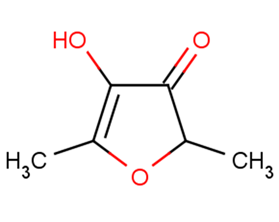
4-Hydroxy-25-dimethyl-3(2H)furanone
CAS No. 3658-77-3
4-Hydroxy-25-dimethyl-3(2H)furanone( furaneol | HDMF )
Catalog No. M20264 CAS No. 3658-77-3
4-Hydroxy-25-dimethyl-3(2H)furanone is a naturally occurring substance found in a variety of fruits. It has been shown to have antimicrobial activity.
Purity : >98% (HPLC)
 COA
COA
 Datasheet
Datasheet
 HNMR
HNMR
 HPLC
HPLC
 MSDS
MSDS
 Handing Instructions
Handing Instructions
| Size | Price / USD | Stock | Quantity |
| 1G | 35 | In Stock |


|
Biological Information
-
Product Name4-Hydroxy-25-dimethyl-3(2H)furanone
-
NoteResearch use only, not for human use.
-
Brief Description4-Hydroxy-25-dimethyl-3(2H)furanone is a naturally occurring substance found in a variety of fruits. It has been shown to have antimicrobial activity.
-
Description4-Hydroxy-25-dimethyl-3(2H)furanone is a naturally occurring substance found in a variety of fruits. It has been shown to have antimicrobial activity.
-
In Vitro——
-
In Vivo——
-
Synonymsfuraneol | HDMF
-
PathwayGPCR/G Protein
-
TargetAntibacterial
-
RecptorAntibacterial
-
Research Area——
-
Indication——
Chemical Information
-
CAS Number3658-77-3
-
Formula Weight128.13
-
Molecular FormulaC6H8O3
-
Purity>98% (HPLC)
-
SolubilityDMSO: 20 mg/mL (156.09 mM)
-
SMILESCC1OC(C)=C(O)C1=O
-
Chemical Name——
Shipping & Storage Information
-
Storage(-20℃)
-
ShippingWith Ice Pack
-
Stability≥ 2 years
Reference
1.Myers AJ et al. Contribution of lean fat muscle color and degree of doneness to pork and beef species flavor. Meat Sci. 2009 May;82(1):59-63.
molnova catalog



related products
-
Sulfaperin
Sulfaperin is a sulfonamide antibacterial agent.
-
TH1020
TH1020 is a novel Inhibitor of Toll-Like Receptor 5 (TLR5)/Flagellin Complex with promising activity (IC50 =0.85±0.12?μm) and specificity.
-
Mecillinam
Mecillinam, an extended-spectrum penicillin antibiotic, is considered to be active against Gram-negative bacteria by binding specifically to penicillin-binding protein 2 (PBP2).



 Cart
Cart
 sales@molnova.com
sales@molnova.com


